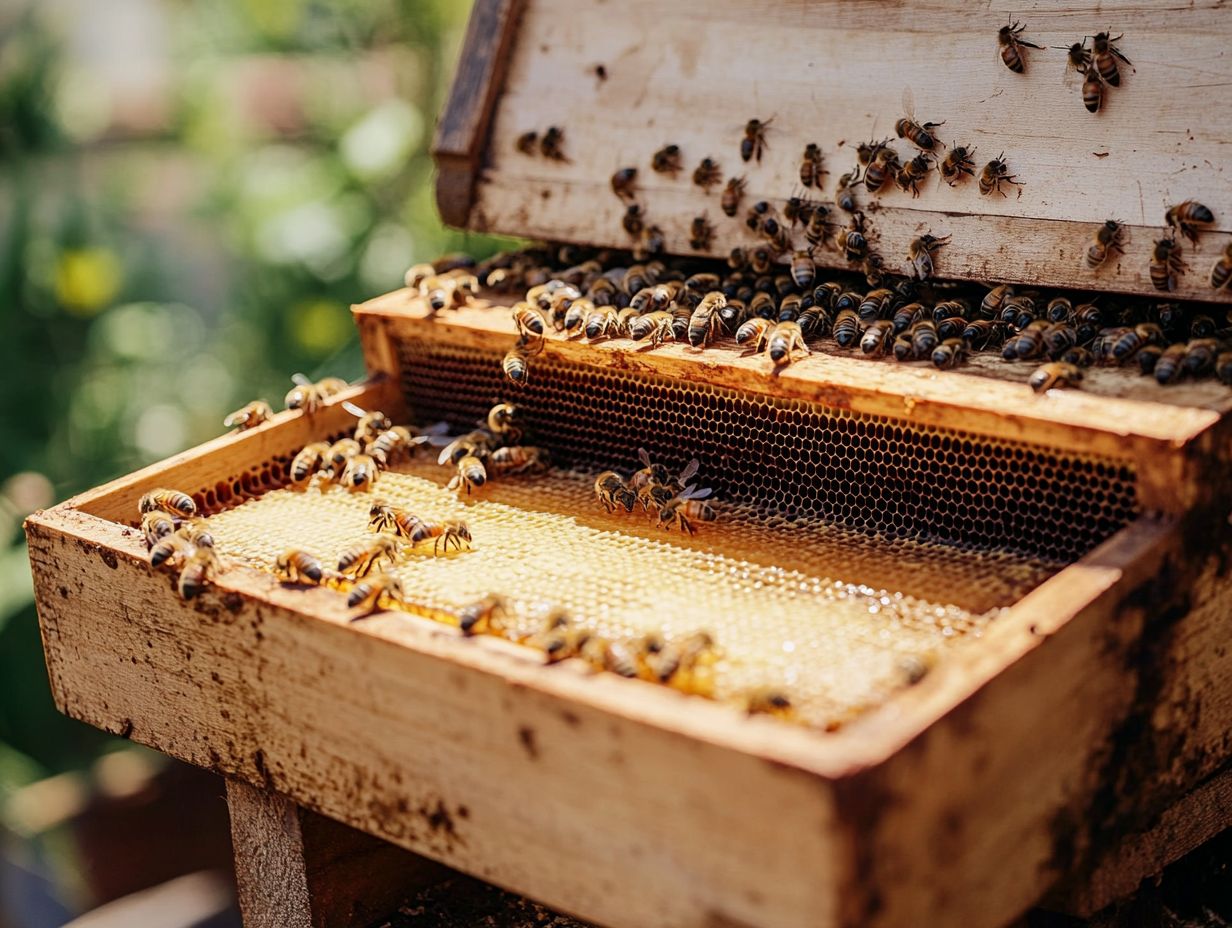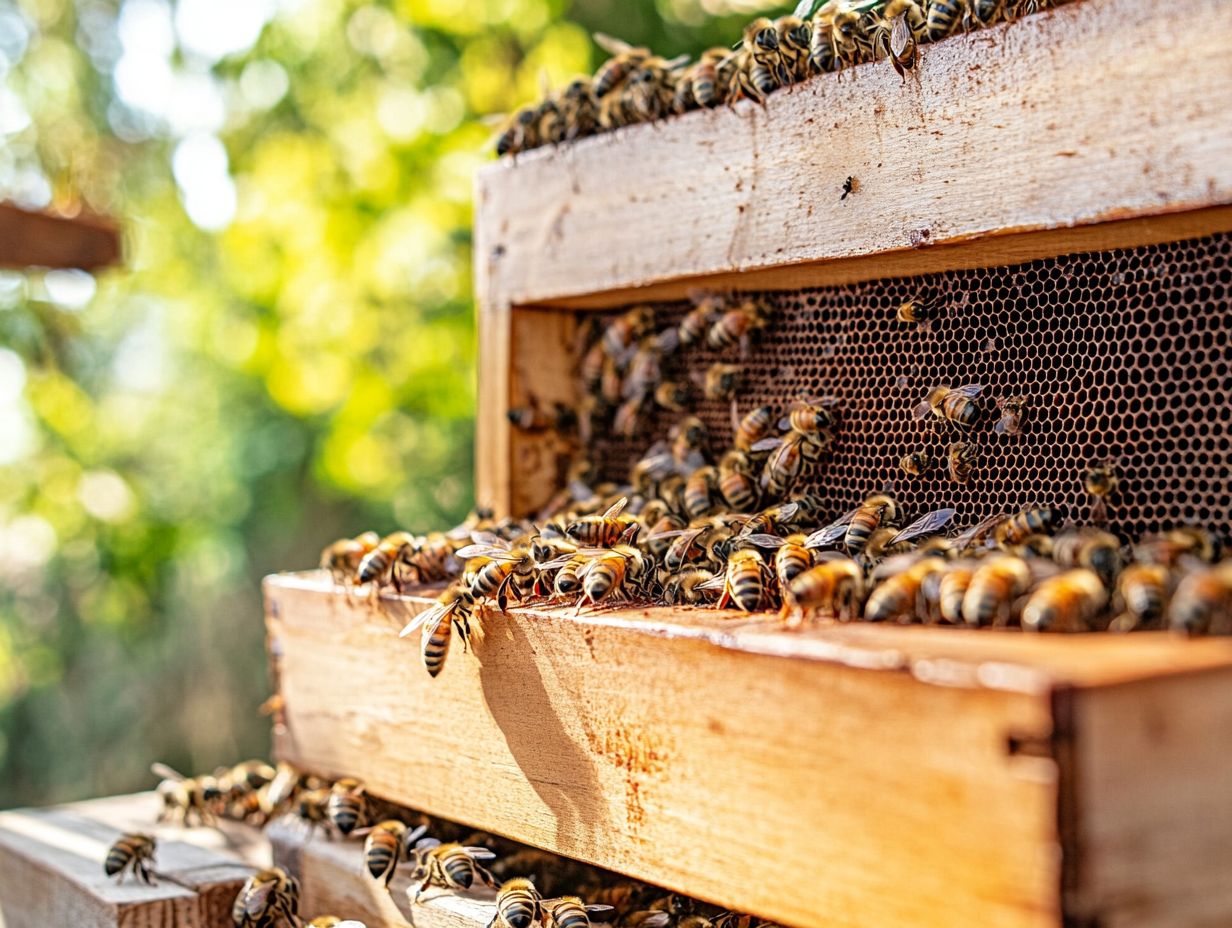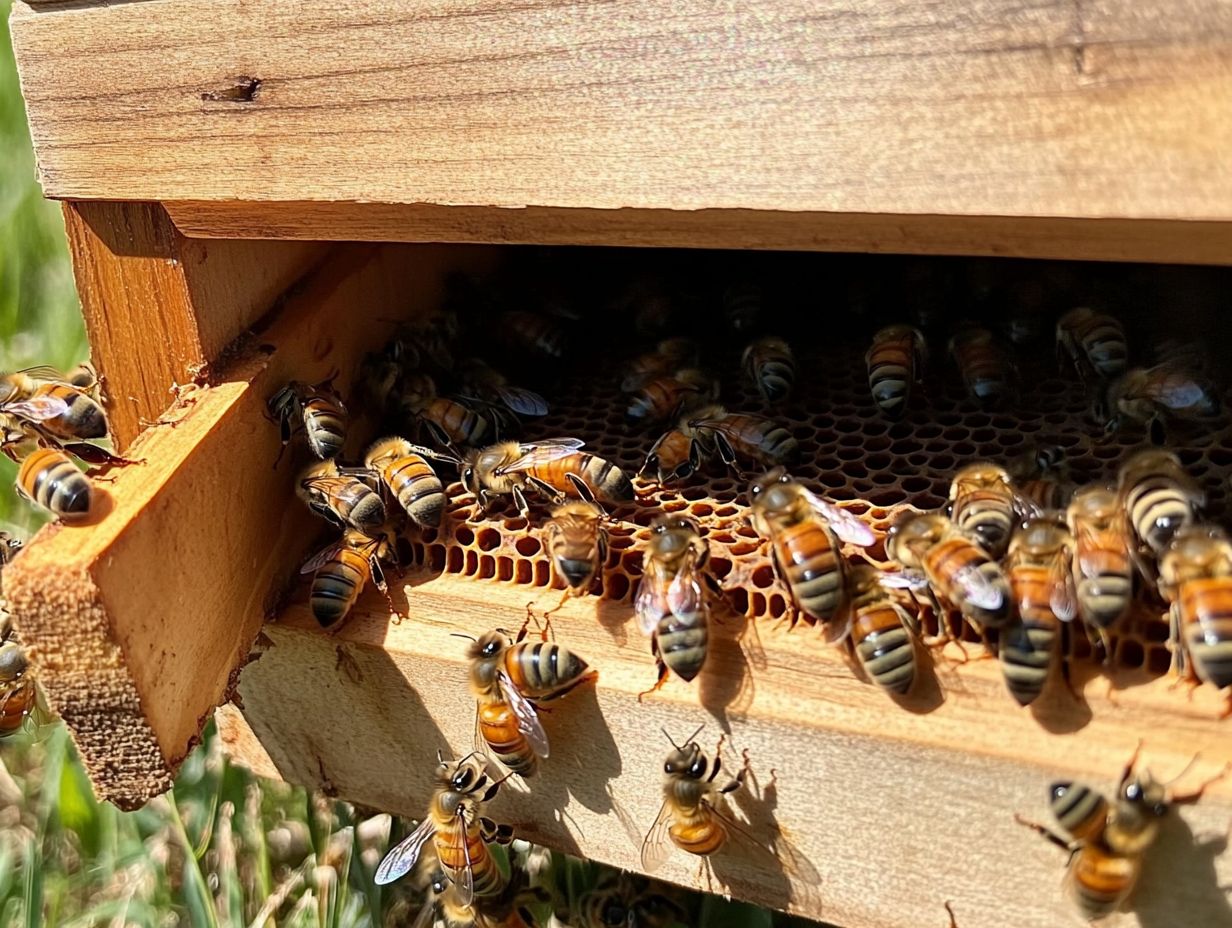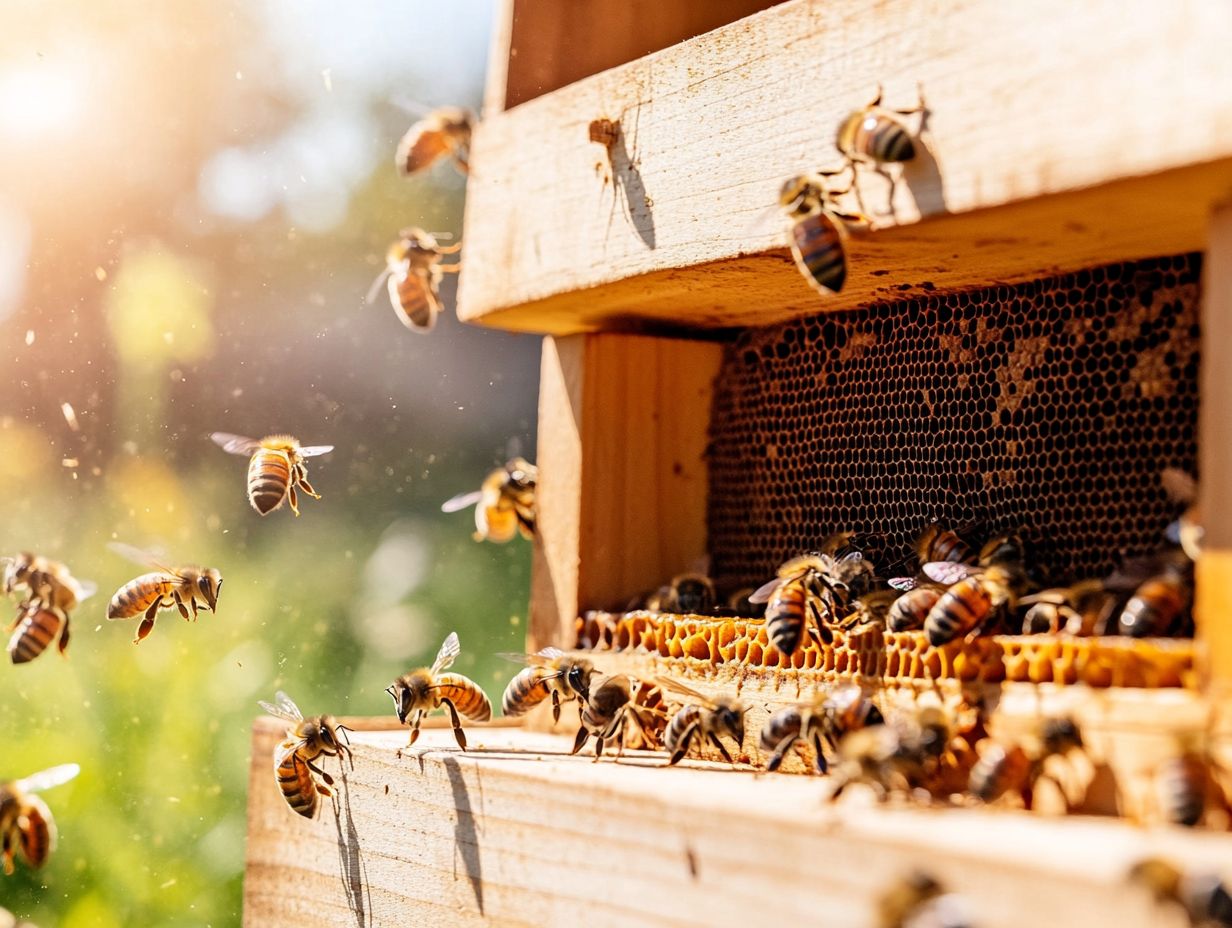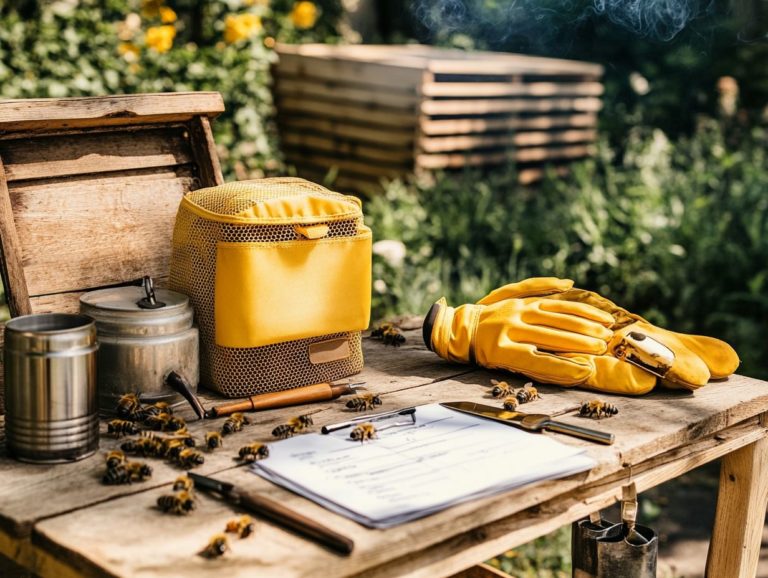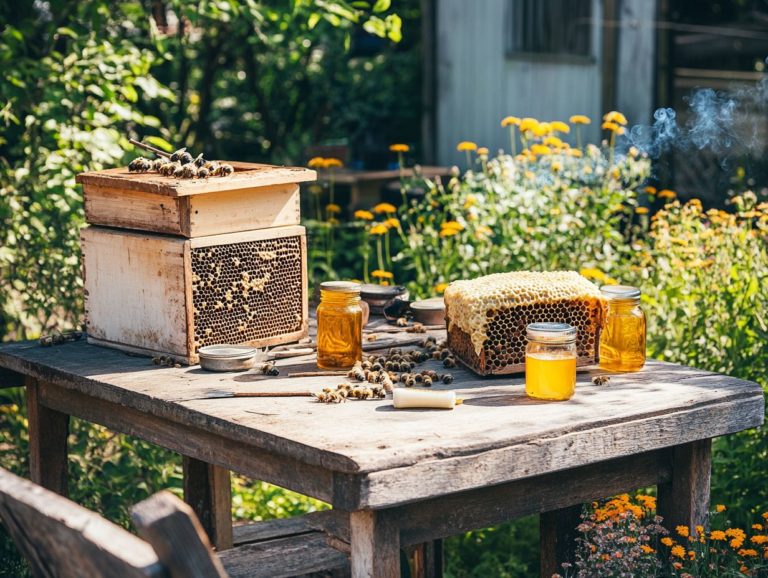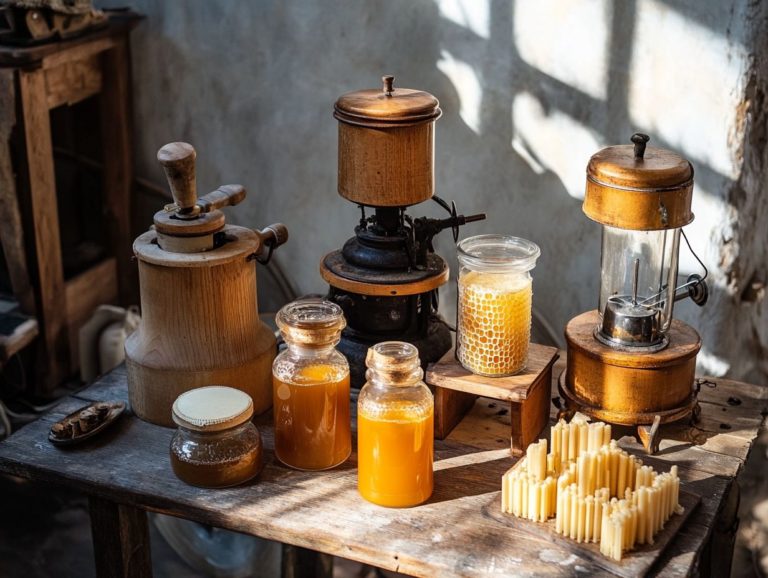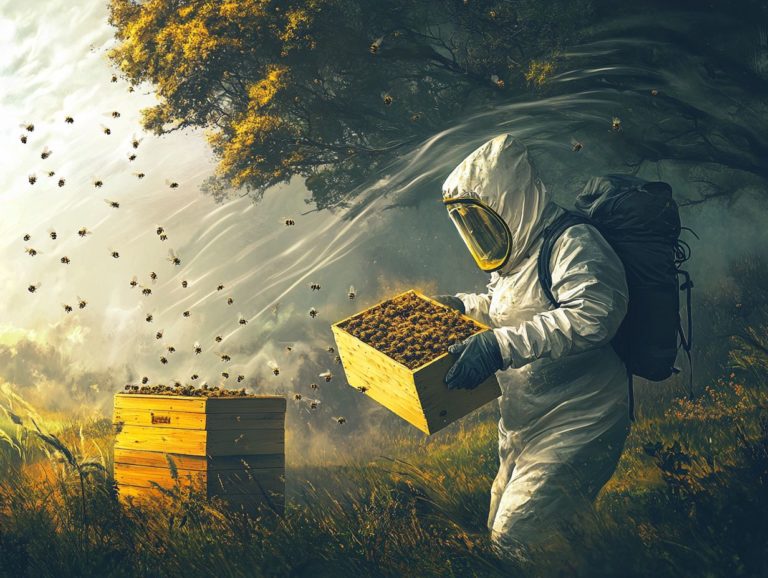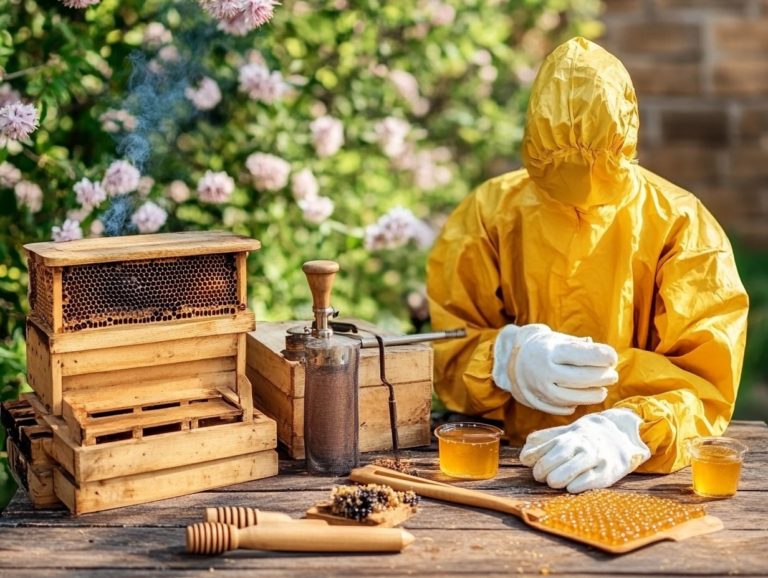The Role of Queen Excluders in Beekeeping
In the realm of beekeeping, creating the perfect hive environment is essential for both you and your bees, especially when using various beekeeping supplies. Let’s explore the amazing benefits of queen excluders!
One indispensable tool in your arsenal is the queen excluder, a device specifically crafted to regulate the queen bee’s movement within the hive, helping the baby bees grow and facilitating effective hive management.
This article delves into the vital role of queen excluders, including plastic queen excluders and stainless steel excluders. You’ll learn how they operate, the different types available, and the benefits and drawbacks of using them. Dive into this exploration now and unlock the secrets to thriving beekeeping!
You’ll also uncover effective methods for installing and maintaining these tools, focusing on excluder cleaning and hive inspection, ensuring your hive thrives.
Contents
- Key Takeaways:
- Why Is a Queen Excluder Used in Beekeeping?
- How Does a Queen Excluder Work?
- What Are the Different Types of Queen Excluders?
- What Are the Benefits of Using a Queen Excluder?
- What Are the Drawbacks of Using a Queen Excluder?
- How to Properly Install and Use a Queen Excluder?
- When Should a Queen Excluder Be Removed?
- Frequently Asked Questions
Key Takeaways:
- A queen excluder is a physical barrier used in beekeeping to prevent the queen from laying eggs in honey supers and brood boxes, keeping them clean for harvesting.
- Queen excluders are made from various materials, such as metal, plastic, and wood, including wood-bound excluders, each with their own benefits and drawbacks.
- Proper installation and regular maintenance of queen excluders can help prevent brood in honey supers, keep the queen in the brood chamber, and reduce swarming in the hive.
Why Is a Queen Excluder Used in Beekeeping?
A queen excluder is an essential tool in your beekeeping arsenal, expertly crafted to help you manage your hives and maximize honey production, especially during the honey flow. This device plays a pivotal role in maintaining the health and productivity of your bee colonies by regulating the movement of the queen bee and nurse bees.
By preventing the queen from accessing honey supers, it effectively stops brood from encroaching on honey storage areas. This enhances your hive management efficiency and allows for better honey extraction. This ensures that your colony flourishes, even in the face of challenges like varroa mite infestations—which can harm bees—and wax moths.
How Does a Queen Excluder Work?
A queen excluder serves as an essential physical barrier within the hive. It allows worker bees to move freely while effectively limiting the queen bee’s access and helping the baby bees grow. This tool helps keep baby bees safe and organized in the hive.
By managing the queen’s egg-laying areas within the brood nest, you can influence the hive’s structure. This fosters healthy growth and honey production, ultimately cultivating a thriving colony.
1. Physical Barrier
The queen excluder acts as a crucial barrier, regulating the movement of bees, including worker bees, within the hive and primarily keeping the queen bee confined to the brood chamber. This design is essential for effective hive management as it prevents unwanted brood from encroaching upon honey supers, significantly impacting your honey production and overall colony population.
By enforcing this separation, the excluder plays a pivotal role in enhancing bee behavior, bee-centric beekeeping, and hive dynamics. It encourages your foraging bees to concentrate their efforts on honey collection, which is crucial during the honey flow, rather than brood rearing, maximizing the conversion of nectar into honey.
This arrangement cultivates a healthier brood nest environment and reduces the risk of honey-bound conditions—where bees find themselves unable to store new nectar due to limited space, affecting honey production. When honey supers remain free of brood, they promote better airflow and reduced moisture, both of which are vital for the overall vitality of your hive.
Now that you understand the importance of queen excluders, consider implementing what you’ve learned to enhance your beekeeping experience!
2. Size Restrictions
One standout feature of a queen excluder is its clever design. It allows only worker bees to pass through while keeping the larger queen and her male offspring (drone brood) confined. This selective permeability is essential for maintaining colony dynamics.
It creates optimal conditions for brood rearing and honey storage. The specific dimensions of the excluder prevent the queen from laying eggs in honey supers, ensuring worker bees can efficiently forage, especially during peak seasons.
By keeping drones, which are larger than workers, in the lower chamber, competition for resources is minimized. This enhances colony health and allows worker bees to focus on their essential roles.
What Are the Different Types of Queen Excluders?
You’ll find a variety of queen excluders designed specifically for beekeepers, including plastic queen excluders and wood bound excluders, each tailored to suit different management styles and personal preferences. The most prevalent materials include metal, plastic, and wood, each presenting its own set of benefits and drawbacks that significantly affect hive conditions and honey production.
Selecting the perfect queen excluder is vital for successful hive management, particularly when considering queen excluder types to avoid complications like honey-bound frames.
1. Metal Queen Excluders
Metal queen excluders are celebrated for their durability and long-lasting performance, making them a favored option among beekeepers. These excluders can withstand various environmental conditions and are much less prone to warping than their plastic counterparts, which is essential for maintaining the stability of your hive.
With their rigid structure, they allow for straightforward installation while ensuring that worker bees can pass through, all while keeping the queen from laying eggs in the honey supers and enhancing honey storage efficiency.
However, it’s worth noting that metal queen excluders can present challenges, such as added weight and the risk of rusting if not cared for properly during hive inspections. Regular inspection and occasional cleaning are necessary to maintain their best performance.
Many beekeepers appreciate the reliability of metal options. However, preferences can vary based on individual experiences and specific hive conditions. Understanding the balance between the advantages and drawbacks is vital as you select the best equipment for effective hive management.
2. Plastic Queen Excluders
Plastic queen excluders present a lightweight alternative to their metal counterparts, making them easy to handle during hive inspections and management, but they may require more frequent maintenance. While they are often budget-friendly, you might find they need a bit more attention due to their susceptibility to warping and wear in certain hive conditions, especially when dealing with drone brood.
This consideration is essential for beekeepers focused on achieving optimal hive health and maximizing honey production, particularly during the honey extraction process. The ease of handling these excluders can significantly enhance the speed and efficiency of your inspections.
However, the trade-off often comes down to durability; issues like bending or cracking may mean you have to replace them more frequently than metal options, affecting your overall honey production. This factor plays a crucial role in shaping beekeeper preferences, as some individuals prioritize robust equipment that can endure varying weather conditions, ultimately influencing their overall colony management strategies.
Regarding honey yields, maintaining a well-kept excluder can significantly impact brood patterns, which in turn affects production rates.
3. Wooden Queen Excluders
Wooden queen excluders, crafted from natural materials, present a distinctive aesthetic and insulation properties. They provide excellent thermal regulation that can significantly enhance hive conditions. While they may be less common than their metal or plastic counterparts, wooden queen excluders appeal to beekeepers who prefer a more traditional approach to colony management and effective brood rearing.
Not only do these excluders elevate the visual appeal of a beehive, but they also ensure a stable environment that is critical for the health of the colony and effective brood management. By keeping the brood area warm, wooden queen excluders support optimal brood development. This ultimately boosts honey production and promotes a robust colony.
However, don’t forget that wooden designs may demand more maintenance due to their potential wear and susceptibility to moisture, especially in varying seasonal conditions. Despite these challenges, many enthusiasts find that the strong and natural insulation properties of wooden excluders often outweigh the drawbacks. This allows for effective hive management and promotes healthy bee colonies.
What Are the Benefits of Using a Queen Excluder?
The benefits of employing a queen excluder are significant for both novice and experienced beekeepers. Understanding the queen excluder benefits can enhance your overall hive management.
One primary advantage is its ability to prevent brood from developing in honey supers. This ensures optimal honey production and maintains the cleanliness of honey storage.
By keeping the queen confined within the brood chamber, you promote a healthy colony structure. Queen excluders also help reduce swarming—a common challenge in beekeeping that can diminish your colony’s population and impact your honey crop, essential for successful beekeeping.
1. Prevents Brood in Honey Supers
One of the significant benefits of using a queen excluder is its remarkable ability to prevent brood from developing in honey supers. This safeguards the honey production process and ensures cleaner honey extraction. By restricting the queen’s access to these storage areas, the honey you harvest stays free from impurities, resulting in a higher-quality honey crop.
This practice not only enhances the flavor of your honey but also improves its storage capabilities. Honey that is free from pollen and brood cappings enjoys a longer shelf life. Keeping a clean and broodless honey super optimizes hive conditions and greatly influences the overall productivity of your bees.
When your bees thrive in a well-managed environment, they can concentrate their energy on foraging and honey production instead of tending to brood. In the long run, this strategy can lead to healthier colonies that can thrive amidst environmental challenges.
Ultimately, when your bees effectively manage their resources, it supports sustainability and aligns with the principles of bee-centric beekeeping in their foraging efforts.
2. Keeps the Queen in the Brood Chamber
One of the standout advantages of queen excluders, such as plastic or stainless steel types, is their remarkable ability to keep the queen confined to the brood chamber. This ensures she can lay her eggs in a designated area, maintaining a consistent population of worker bees.
This level of control is essential for effective colony management—how you take care of the bee community—and plays a pivotal role in sustaining the health and productivity of the hive, which means how much honey they can produce.
By restricting the queen to this specific section, you can optimize her reproductive efficiency. This ultimately strengthens the overall vitality of the colony.
With a robust population of worker bees, important jobs like gathering food and caring for the hive are done better. A thriving colony excels at honey production since a strong workforce is crucial for gathering nectar and transforming it into honey.
This strategic approach to managing the queen cultivates a thriving hive environment and supports the intricate dynamics that underpin sustainable beekeeping practices.
3. Reduces Swarming
Using a queen excluder can dramatically curb swarming tendencies in your bee colonies, which is vital for maintaining a strong population. Swarming is when bees leave to start a new colony. By managing the queen’s movements and providing ample space for brood rearing, this is a key aspect of maintaining a strong colony.
You can significantly enhance the stability of your hives and bolster your beekeeping success.
Minimizing swarming not only safeguards the overall strength of your colony but also boosts honey production. When swarming is kept in check, your bees can channel their energy into foraging and nectar collection instead of splitting off to form new colonies.
Imagine the benefits! Take, for example, a beekeeper in North Carolina who adopted queen excluders and experienced an impressive surge in honey yield. This real example shows how effective queen excluders can be, with reports of up to 50% more honey harvested during peak bloom periods.
This proactive strategy not only reaps immediate rewards but also cultivates long-term benefits. It ensures that your colonies remain vigorous, productive, and well-equipped to thrive amidst environmental challenges. Ultimately, this leads to sustained success in your beekeeping endeavors.
What Are the Drawbacks of Using a Queen Excluder?
While queen excluders provide a range of benefits, it’s crucial to consider the drawbacks carefully. One significant concern is the risk of injury to the queen or worker bees if the excluder isn’t designed or maintained with care.
Introducing an excluder can occasionally lead to heightened hive congestion. This can affect the hive’s behavior, especially during inspections, and the overall dynamics of the hive.
1. Potential for Injury to Queen or Workers
One notable drawback of using a queen excluder is the risk of injury to either the queen bee, the pivotal figure in colony management and health, or the worker bees. This is especially true if the device isn’t well-designed or suffers damage over time.
These injuries can induce stress within the colony, ultimately affecting its overall productivity. When queen bees or their workers sustain injuries from poorly configured excluders, it disrupts the delicate balance of the hive.
This disruption can hinder the colony’s foraging capabilities and honey production. It jeopardizes not only the hive’s survival but also the economic viability of a hive.
For beekeepers, it is important to consider the various types of queen excluders available. Regular inspections of these devices are essential to ensure their integrity and functionality.
By performing frequent maintenance, beekeepers can prevent mechanical flaws that might cause harm, fostering a healthier and more productive colony environment.
2. Increased Hive Congestion
A key issue for beekeepers is increased hive congestion. This can stress bee behavior when a queen excluder is in place.
With the queen confined to the brood chamber, worker bees may have limited movements. This can lead to stress and behavior changes.
This congestion hinders the raising of young bees, as the workers struggle to deliver food and care to the larvae effectively. Overcrowding may result in reduced honey production since bees tend to be less productive when their space is restricted, ultimately affecting the colony’s ability to thrive.
Environmental conditions like temperature and humidity can further exacerbate these challenges, creating an imbalance in hive dynamics. Therefore, it’s crucial for you to manage the hive’s space wisely. Consider incorporating alternative methods or temporarily removing the excluder during peak nectar flows to ensure optimal colony health and maintain strong honey yields.
How to Properly Install and Use a Queen Excluder?
Proper installation and usage of a queen excluder are essential for maximizing its benefits in your beekeeping efforts. To effectively manage your hive, it’s important to thoughtfully consider where to place the excluder and stick to a regular maintenance schedule.
These factors affect brood rearing and your colony’s health, ensuring that your bees thrive under your care.
1. Placement in the Hive
The correct placement of a queen excluder is crucial for its effectiveness. It directly influences your hive management practices and honey production outcomes. You should position the excluder between the brood frames, which need careful monitoring to ensure the queen remains where she should, and honey supers should be strategically placed to boost production. This prevents the queen from accessing the storage areas while allowing the worker bees to move freely.
This strategic positioning not only safeguards the quality of your honey by keeping it free from brood but also optimizes the dynamics within the hive. The worker bees can easily transport nectar into the supers for storage. Inspect the excluder regularly to avoid blockages that could harm your hive!
Placing it in the right orientation can enhance airflow within the hive, boosting the overall health of your bees. By understanding these best practices, you can significantly impact both your honey production and the vitality of your colony.
2. Regular Maintenance and Inspection
Regular maintenance and inspection of queen excluders are essential practices to ensure their ongoing effectiveness in managing your hives. This includes routine cleaning of the excluders and checking for any damage or wear that could compromise their function, ultimately affecting the conditions and productivity of your hive.
By thoughtfully integrating a comprehensive cleaning schedule into your beekeeping routine, you can significantly enhance colony health. This involves removing any residual wax, debris, or propolis that may accumulate over time, as these substances can obstruct the movement of bees and lead to inefficiencies.
During your inspections, be sure to look for cracks or deformities that might allow queens to pass through where they shouldn’t, risking the organization of your colony. A properly maintained excluder not only secures the queen but also fosters a more successful foraging and breeding environment, ensuring that your hive thrives throughout the seasons.
When Should a Queen Excluder Be Removed?
Understanding when to remove a queen excluder is as crucial as knowing when to install it for optimal hive management. During honey flow periods, which are crucial for producing honey, just before winter, and during requeening, it’s essential to weigh the consequences of keeping the excluder in place.
This decision can significantly influence both honey production and the overall health of your colony.
1. During Honey Flow
During honey flow, removing the queen excluder gives your worker bees unrestricted access to honey supers. This boosts honey production significantly. By allowing the queen to lay eggs freely, you help maintain a strong and productive colony.
This strategy nurtures a healthier hive environment. Your worker bees can gather more nectar and transform it into honey, maximizing your yield. Without the queen excluder, colony dynamics improve. This reduces congestion and encourages increased foraging activities.
As your colony extends its foraging efforts, you create greater opportunities for pollination in the surrounding areas. This benefits both your hive and the local flora. The cooperative behaviors of your bees flourish, resulting in a harmonious balance that promotes a thriving atmosphere during this critical honey-producing season.
2. Before Winter
Before winter sets in, consider removing the queen excluder. This gives the queen greater mobility, which is crucial for maintaining optimal hive conditions as temperatures drop.
Allowing the queen to move freely enhances the colony’s ability to cluster effectively for warmth. This significantly increases their chances of surviving the winter months.
Encouraging the queen’s movement promotes the production of winter bees. Winter bees are special bees that help the colony survive during colder months. Without the queen excluder, communication among the bees improves. This allows them to organize resources and manage food reserves more efficiently.
This practice supercharges thermal regulation within the hive and helps to lower stress levels among the bees. By focusing on these crucial aspects, you can cultivate a healthier and more resilient colony, ultimately enhancing your hive’s prospects of thriving through the winter.
3. When Requeening
When you’re requeening a hive, it’s crucial to remove the queen excluder. This step facilitates the migration of the new queen and allows her to establish herself properly within the colony.
Neglecting this important action can inhibit the queen’s movement. This may lead to stress among the bees and potential rejection of their new leader. By granting the new queen unrestricted access, you can significantly enhance acceptance rates and minimize disruptions in the colony’s dynamics.
A smooth integration fosters a thriving hive and promotes stability in brood production and foraging activities. This strategic approach ultimately supports the long-term health of the colony, making it essential for successful beekeeping practices.
Frequently Asked Questions
- What is the purpose of using queen excluders in beekeeping?
- A queen excluder is a device placed between the brood chamber and honey supers. It prevents the queen from laying eggs in the honey supers, ensuring the production of pure, uncontaminated honey.
- How does a queen excluder work?
- Queen excluders have small openings for worker bees, but they are too small for the larger queen bee. This allows worker bees to move freely between the brood chamber and honey supers, while preventing the queen from accessing the supers.
- When should I use a queen excluder in my beehive?
- Queen excluders are typically used during honey production season, when the beekeeper wants to collect pure honey from the supers without any brood or eggs mixed in. They are not necessary when the hive focuses on brood production.
- Are there any downsides to using a queen excluder?
- While queen excluders help in honey production, they can also cause problems. Some beekeepers believe they restrict the queen’s movement and disrupt the hive’s natural behavior. If not properly spaced and maintained, they can become clogged with debris, preventing worker bees from moving freely.
Apply these tips to ensure your hive’s health and productivity. Happy beekeeping!
Do all beekeepers use queen excluders?
No, not all beekeepers use queen excluders. Some allow their bees to manage the brood and honey production naturally. Others prefer physical barriers to separate the brood chamber from the honey supers.
How do I properly maintain a queen excluder?
Keep your queen excluders in top shape by inspecting and cleaning them regularly. Make sure there’s about a quarter inch of clearance on each side for worker bees to pass through easily.
Act fast! Look for signs of rust on metal excluders and replace them if needed.

